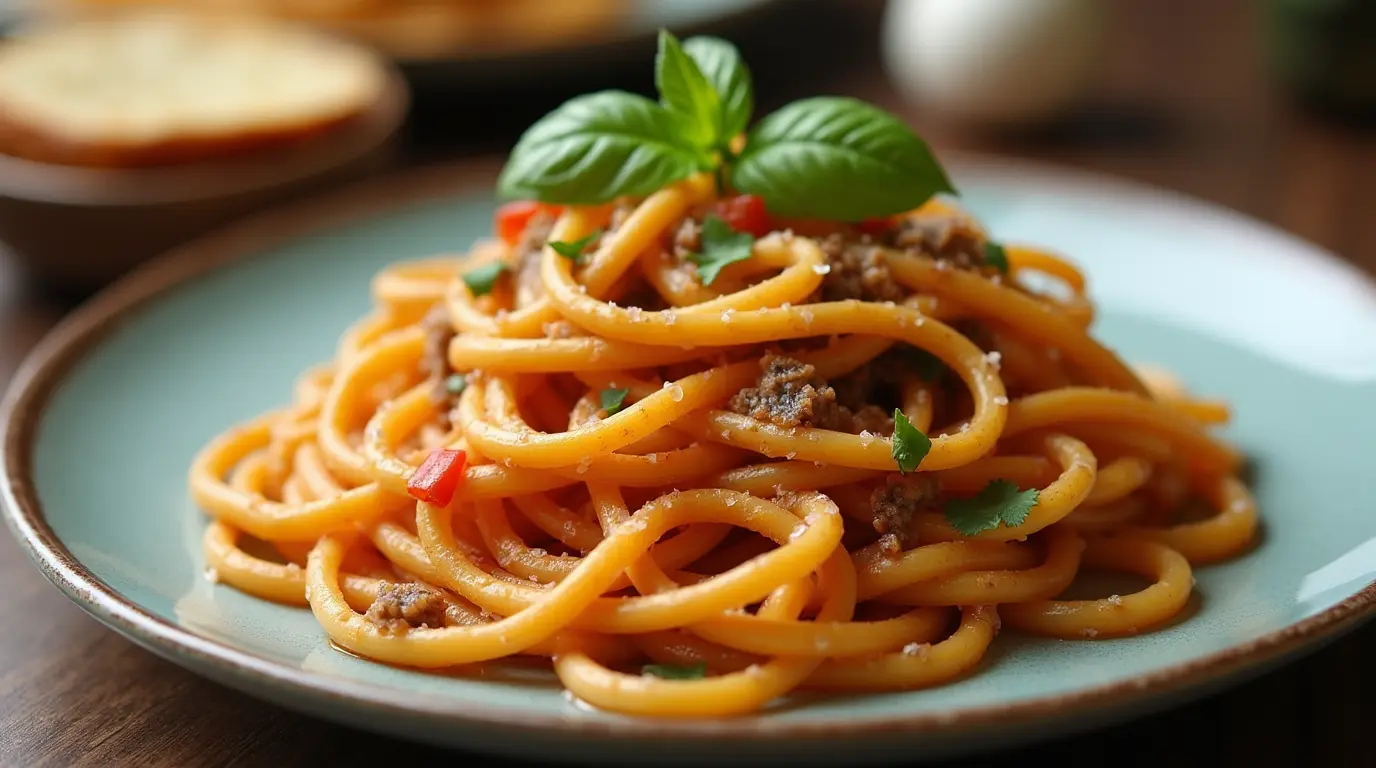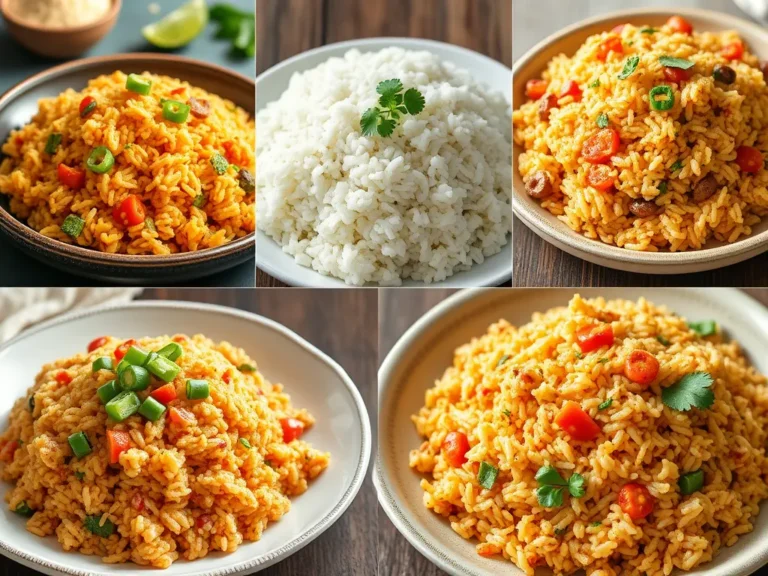Turkish Pasta Recipe: How to Make It in 30 Minutes

Turkish Pasta Recipe
Table of Contents
Did You Know There’s a Pasta Dish That Combines Mediterranean Flavors in Just Half an Hour?
Have you ever wondered if there’s a way to enjoy the rich flavors of Turkish cuisine without spending hours in the kitchen? Most people think authentic international dishes require complicated techniques and hard-to-find ingredients,
but what if you could create a delicious Turkish pasta recipe in 30 minutes with items already in your pantry? This quick and satisfying meal might just change how you think about weeknight cooking!
What Makes This Turkish Pasta Recipe Special
This Turkish pasta recipe stands out because it brings together the bold flavors of Mediterranean cuisine in a quick, family-friendly format. Unlike traditional Turkish dishes that might simmer for hours, this pasta comes together in just 30 minutes without sacrificing any of the authentic taste.
Time Required: 30 minutes total (10 minutes prep, 20 minutes cooking)
Difficulty Level: Easy – perfect for beginners!
Serves: Makes 4 generous portions
The magic of this Turkish pasta recipe is in its balance of flavors and textures. The pasta provides a neutral base that soaks up the rich tomato sauce, while the yogurt adds creaminess and tang. Fresh herbs and spices bring brightness and warmth, creating a harmonious dish that tastes like it’s been cooking all day, even though you just whipped it up after work!

Essential Ingredients for the Perfect Turkish Pasta Recipe
Base Ingredients
- 8 ounces (225g) pasta – Traditional Turkish pasta recipes often use wide noodles like pappardelle or fettuccine, but any pasta works well
- 2 tablespoons olive oil – Provides a rich foundation for the sauce
- 1 medium onion, finely diced – Creates a sweet base flavor
- 2 cloves garlic, minced – Adds aromatic depth to your Turkish pasta recipe
- 1 pound (450g) ground lamb or beef – Traditional protein in Turkish cuisine
- 2 tablespoons tomato paste – Adds richness and umami flavor
- 1 can (14 oz/400g) diced tomatoes – Form the base of the sauce
- 1 teaspoon each of paprika, cumin, and dried mint – The signature spice blend for this Turkish pasta recipe
- ½ teaspoon red pepper flakes (optional) – Adds a gentle heat
- Salt and black pepper to taste – Enhances all other flavors
For Serving
- 1 cup plain yogurt – The cooling, tangy element that makes this Turkish pasta recipe special
- 2 tablespoons butter – For the authentic finishing touch
- ¼ cup chopped fresh herbs (parsley, mint, or dill) – Brightens the dish
- 2 tablespoons toasted pine nuts (optional) – Adds crunch and nutty flavor
Why These Ingredients Matter
The success of your Turkish pasta recipe relies on the harmony between ingredients. The meat provides richness, while tomatoes add acidity and sweetness. The yogurt is especially important, creating a creamy counterpoint to the spiced meat sauce. This combination is what makes Turkish pasta different from Italian pasta dishes, giving it a unique flavor profile that’s both familiar and exotic.
Possible Substitutions
- Pasta: Any pasta shape works in this Turkish pasta recipe! Try penne, fusilli, or even orzo
- Meat: Vegetarians can substitute 2 cups of chopped mushrooms or 1 cup of cooked lentils
- Yogurt: Greek yogurt gives a thicker sauce, while plant-based yogurt works for a dairy-free Turkish pasta recipe
- Spices: If you don’t have dried mint, add 2 tablespoons of fresh mint at the end of cooking

Step-by-Step Instructions for Turkish Pasta
Preparation
- Bring a large pot of salted water to a boil for your pasta. Using plenty of water and salt is key for a good Turkish pasta recipe.
- While waiting for the water to boil, dice the onion and mince the garlic. Having these ready before you start cooking helps this Turkish pasta recipe come together quickly.
- Measure out all spices into a small bowl so they’re ready to add at once. This technique, called “mise en place,” makes cooking this Turkish pasta recipe much easier.
- Heat olive oil in a large skillet over medium heat until it shimmers but doesn’t smoke.
Cooking the Sauce
- Add the diced onion to the hot oil and cook for 3-4 minutes until softened and translucent. Stir occasionally to prevent browning, as we want sweet, not caramelized, onions for this Turkish pasta recipe.
- Add the minced garlic and cook for 30 seconds until fragrant. Don’t let it brown, or it will become bitter.
- Add the ground meat and break it apart with a wooden spoon. Cook for 5-7 minutes until no pink remains and it starts to brown. This browning adds flavor to your Turkish pasta recipe.
- Stir in the tomato paste and cook for 1 minute, allowing it to caramelize slightly. This develops a deeper flavor in your sauce.
- Add the diced tomatoes with their juice, paprika, cumin, dried mint, and red pepper flakes (if using). Stir well to combine all ingredients of your Turkish pasta recipe.
- Season with salt and black pepper to taste. Remember that the pasta water and yogurt will add some saltiness too, so go easy at first.
- Reduce heat to medium-low and simmer for 10 minutes, stirring occasionally. The sauce should thicken slightly but remain saucy enough to coat the pasta well.

Cooking the Pasta
- While the sauce simmers, cook the pasta according to package directions until al dente (still slightly firm when bitten). For the best Turkish pasta recipe results, cook it 1 minute less than the package suggests.
- Before draining, reserve 1/2 cup of the starchy pasta water. This secret ingredient helps bind your Turkish pasta recipe together.
- Drain the pasta, but don’t rinse it. The starch on the outside helps the sauce cling better.
Finishing Touches
- In a small saucepan, melt the butter over low heat until it just begins to bubble.
- Return the drained pasta to its cooking pot and add a splash of the reserved pasta water.
- Add the meat sauce to the pasta and toss gently to combine. If it seems dry, add a bit more pasta water until it reaches your desired consistency.
Pro Tips for a Successful Turkish Pasta Recipe
- Don’t overcook the pasta – Keep it al dente as it will continue cooking slightly when mixed with the hot sauce.
- Taste and adjust seasoning before serving – The flavors should be bold but balanced in a good Turkish pasta recipe.
- Let the yogurt come to room temperature before serving for a smoother sauce that won’t cool down your pasta.
- Toast the pine nuts carefully in a dry skillet, watching closely as they can burn quickly.
Perfecting Your Turkish Pasta Assembly and Presentation
The assembly of this Turkish pasta recipe is what makes it uniquely Turkish rather than Italian. Here’s how to bring it all together for an authentic presentation:
Traditional Assembly Method
- Place pasta in individual shallow bowls or on plates with a slight rim to contain the sauce.
- Spoon the meat sauce generously over the pasta, covering it completely.
- Add a large dollop (about 1/4 cup) of yogurt on top or to the side of each serving. Don’t mix it in completely – in authentic Turkish pasta recipes, diners mix the yogurt in as they eat.
- Drizzle each serving with some of the melted butter. This step is essential to an authentic Turkish pasta recipe!
- Sprinkle with chopped fresh herbs and toasted pine nuts if using.

Modern Presentation Ideas
- Family style: Place the pasta in a large serving bowl, top with sauce, and add dollops of yogurt around the edges. Drizzle with butter and sprinkle with herbs. Let everyone serve themselves and mix as they prefer.
- Deconstructed: Arrange pasta on one side of the plate, meat sauce on the other, with yogurt in its small bowl on the side. This looks impressive and lets diners control how much of each component they want.
- Layered: In individual gratin dishes, layer pasta, then meat sauce, then a yogurt layer, and top with butter, herbs, and pine nuts. This creates a Turkish pasta recipe that’s almost like a quick pasta bake.
Garnishing Tips
- Fresh herbs should be added at the very last minute to preserve their bright color and flavor.
- A light dusting of extra paprika adds beautiful color to your Turkish pasta recipe.
- A lemon wedge on the side allows diners to add a squeeze of brightness if desired.
- For special occasions, garnish with pomegranate seeds for a pop of color and sweet-tart flavor that complements this Turkish pasta recipe beautifully.
Storage and Make-Ahead Tips for Turkish Pasta
This Turkish pasta recipe works wonderfully for meal prep and leftovers, though some components are best kept separate for optimal freshness.
Refrigerator Storage
- Store pasta and sauce together in an airtight container for up to 3 days. The flavors of this Turkish pasta recipe improve overnight as the spices meld.
- Keep yogurt separate and add fresh when reheating. Yogurt can separate when reheated, affecting the texture of your Turkish pasta recipe.
- Fresh herbs should also be stored separately and added just before serving.
Freezer Storage
- The meat sauce freezes beautifully for up to 3 months. Portion it into freezer-safe containers for quick future meals.
- Cook fresh pasta when you’re ready to enjoy your Turkish pasta recipe again. Frozen and reheated pasta can become mushy.
- Never freeze the yogurt topping – always use fresh.
Make-Ahead Options
- Prepare the sauce up to 2 days ahead and refrigerate. This improves the flavor of your Turkish pasta recipe as the spices have more time to meld.
- Cook the pasta just before serving for the best texture.
- Pre-chop herbs and store them in a damp paper towel in the refrigerator for up to 24 hours.
Reheating Tips
- Reheat sauce in a skillet over medium-low heat, adding a splash of water if it’s too thick.
- Freshly cooked pasta is best, but if reheating pasta with sauce, add 1-2 tablespoons of water before microwaving and covering for 1-2 minutes.
- Always add fresh yogurt, butter drizzle, and herbs after reheating your Turkish pasta recipe.
Creative Variations on the Basic Turkish Pasta Recipe
This Turkish pasta recipe is wonderfully versatile. Here are some delicious ways to change it up:
1. Vegetarian Turkish Pasta
Replace the meat with 2 cups of finely chopped mushrooms and 1 cup of cooked lentils or chickpeas. The earthy flavors work beautifully with the spices in this Turkish pasta recipe, and you’ll still get plenty of protein and satisfying texture.
Pro tip: Add 1 tablespoon of soy sauce or 1 teaspoon of miso paste to the mushrooms for extra umami flavor.
2. Seafood Turkish Pasta
Substitute the ground meat with 1 pound of shrimp or cubed firm white fish. Reduce the cooking time for the protein to just 3-4 minutes until it is just cooked through. This creates a lighter version of the Turkish pasta recipe that’s perfect for summer.
Pro tip: Add a pinch of saffron to the sauce for a special occasion seafood Turkish pasta.
3. Spicy Turkish Pasta
Double the red pepper flakes and add 1 finely chopped jalapeño with the onions. For heat lovers, add 1/4 teaspoon cayenne pepper to the spice mix. This creates a Turkish pasta recipe with a pleasant kick that’s balanced by the cooling yogurt.
Pro tip: Offer extra yogurt on the side for those who find it too spicy.
4. Green Turkish Pasta
Add 2 cups of chopped spinach or kale to the sauce during the last 2 minutes of simmering. This adds color, nutrition, and a slight earthy flavor to your Turkish pasta recipe while still keeping it authentic.
Pro tip: A squeeze of lemon juice brightens up the greens and the entire dish.
5. Breakfast Turkish Pasta
Believe it or not, this Turkish pasta recipe makes an amazing breakfast! Simply top leftover pasta and sauce with a fried or poached egg. The runny yolk creates an additional rich sauce that takes this dish to new heights.
Pro tip: Add a few slices of avocado for a modern brunch twist.
Conclusion: Why This Turkish Pasta Recipe Will Become Your New Favorite
This Turkish pasta recipe proves that international cuisine doesn’t have to be complicated or time-consuming to be delicious and authentic. In just 30 minutes, you can transport your taste buds to the Mediterranean with a dish that’s both comforting and exciting.
The beauty of this recipe is in its balance – the warm spices, tangy yogurt, rich butter, and bright herbs all play essential roles in creating a harmonious dish that feels much more special than your typical weeknight pasta. Yet it’s simple enough for beginner cooks to master on the first try.
Don’t be afraid to make this Turkish pasta recipe your own by trying the variations or creating new ones based on what you enjoy or have on hand. The fundamental technique will serve you well no matter how you customize it.
So the next time you’re staring into your pantry wondering what to make for dinner, remember that this Turkish pasta recipe is just 30 minutes away from bringing smiles to everyone at your table. It might just become your new go-to dish for busy weeknights and casual entertaining alike!
Frequently Asked Questions About Turkish Pasta Recipes
Is this an authentic Turkish pasta recipe?
This recipe is inspired by a popular Turkish dish called “Manti,” which traditionally uses tiny dumplings instead of pasta. Our version adapts the flavors for quicker cooking using readily available ingredients while maintaining the authentic flavor profile of yogurt, butter, and spices.
Can I make this Turkish pasta recipe ahead for a party?
Yes! Make the sauce up to two days ahead, and cook the pasta just before serving. Reheat the sauce, toss it with fresh pasta, and add the yogurt, butter, and herbs just before serving.
What kind of yogurt works best in this Turkish pasta recipe?
Plain, unflavored yogurt is traditional. Full-fat provides the richest flavor, but low-fat works, too. Greek yogurt gives a thicker consistency. Avoid vanilla or sweetened yogurts, which would clash with the savory flavors.
Can I use ground turkey or chicken in this Turkish pasta recipe?
Absolutely! While lamb or beef is more traditional, turkey or chicken creates a lighter version. Just be aware that these leaner meats may need a little extra olive oil to prevent dryness.
Is there a dairy-free way to make this Turkish pasta recipe?
Yes! Use plant-based yogurt (unsweetened) and olive oil instead of butter. Coconut yogurt adds richness, while almond or soy yogurts have a milder flavor that lets the spices shine.
What’s the best pasta shape for this recipe?
Wide noodles like pappardelle or fettuccine are closest to traditional Turkish noodles, but this versatile sauce works well with any shape. Curly shapes like fusilli or rotini hold the sauce nicely in their crevices.
How spicy is this Turkish pasta recipe?
As written, it has a mild warmth from the red pepper flakes. You can easily adjust the heat level by changing the amount of red pepper flakes or omitting them entirely for a kid-friendly version.
What can I serve with this Turkish pasta dish?
A simple green salad with lemon dressing makes a perfect companion. For a more substantial meal, add flatbread or crusty bread to soak up the delicious sauce from your Turkish pasta recipe.
Can I add vegetables to this recipe?
Certainly! Bell peppers, zucchini, or eggplant, diced small and cooked with the onion, work well. For a quicker addition, stir in some baby spinach or arugula just before serving until wilted.
What gives this Turkish pasta recipe its unique flavor?
The combination of dried mint (unusual in Western pasta dishes), cumin, and paprika creates a distinctive flavor profile. This spice blend, along with the yogurt and butter topping, is what makes this pasta distinctly Turkish rather than Italian.
Source links
- Greek Yogurt – FAGE or Chobani
- Organic Tomato Paste
- KitchenAid Ice Cream Maker Attachment
- Turkish Dried Mint
- Pasta Shells – De Cecco
Source Links
- Loaded Potato Casserole Recipe Kim J: How to Make It Perfect https://ghitarecipes.com/loaded-potato-casserole-recipe-kim-j/
- Chicken Dressing Recipe: How to Elevate Your Holiday Meal https://ghitarecipes.com/chicken-dressing-recipe/
- Best Tofu Marinade Chicken Recipes: How to Make Them Tasty https://ghitarecipes.com/best-tofu-marinade-chicken-recipes/
- Baked Chicken Cutlet Recipes: How to Make Them Crispy https://ghitarecipes.com/best-tofu-marinade-chicken-recipes/
- Spark Recipes Chicken Taco Soup: How to Make It Flavorful https://ghitarecipes.com/spark-recipes-chicken-taco-soup/
- Diabetic Recipe for Crock Pot Soup with Chicken: How to Serve It https://ghitarecipes.com/diabetic-recipe-for-crock-pot-soup-with-chicken/
- Famous Recipe Chicken Near Me: How to Find the Best Spots https://ghitarecipes.com/famous-recipe-chicken-near-me/
- How to Make the Best Diabetic Crockpot Recipes Gnocchi and Chicken in 5 Steps https://ghitarecipes.com/diabetic-crockpot-recipes-gnocchi-and-chicken-2/
- How to Make the Best Chicken Philly Cheesesteak Recipe in 5 Steps https://ghitarecipes.com/chicken-philly-cheesesteak-recipe/
- Chicken and Cheese Jalousie Recipe: 5 Easy Steps to Make https://ghitarecipes.com/chicken-and-cheese-jalousie-recipe/
- How to Make the Best Chick Fil A Kale Salad Recipe in 5 Steps https://ghitarecipes.com/chick-fil-a-kale-salad-recipe/
- 7 Best Blackstone Chicken Recipes You Need to Try This Season https://ghitarecipes.com/blackstone-chicken-recipes/
- 7 Secrets Behind the Perfect Ground Chicken Mexican Corn Recipe https://ghitarecipes.com/ground-chicken-mexican-corn-recipe-2/
- Why This 3-Ingredient Recipe for Pasta Fazool Made with Chicken Is a Game Changer https://ghitarecipes.com/pasta-fazool-made-with-chicken/
- Braised Chicken in the Oven with Crispy Skin Recipe: 7 Flavor Boosters https://ghitarecipes.com/braised-chicken-in-the-oven-with-crispy-skin/
- Best 7 Ways to Use Chicken_and_cheese_filling in Your Dishes https://ghitarecipes.com/chicken-and-cheese-filling/
- Chicken and Gravy Recipe: How to Make It in 30 Minutes https://ghitarecipes.com/chicken-and-gravy-recipe/






